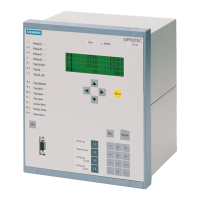Functions
2.1 General
SIPROTEC, 7SD80, Manual
E50417-G1140-C474-A1, Release date 09.2011
41
2.1.4 Oscillographic Fault Records
The 7SD80 multifunctional protection with control is equipped with a fault record memory. The instantaneous
values of the measured values
i
A
, i
B
, i
C
, i
N
, i
Ns
and v
A
, v
B
, v
C
, 3I0
diff
, 3I0
rest
(voltages in accordance with connection) are sampled at intervals of 1.0 ms (for 50 Hz) and stored in a revolving
buffer (20 samples per cycle). In the event of a fault, the data is stored for a set period of time, but not for more
than 5 seconds. Up to 8 fault events can be recorded in this buffer. The fault record memory is automatically
updated with every new fault so that there is no acknowledgment for previously recorded faults required. In ad-
dition to protection pickup, the recording of the fault event data can also be started via a binary input or via the
serial interface.
2.1.4.1 Description
The data of a fault event can be read out via the device interface and evaluated with the help of the SIGRA 4
graphic analysis software. SIGRA 4 graphically represents the data recorded during the fault event and also
calculates additional information from the measured values. Currents and voltages can be presented either as
primary or as secondary values. Signals are additionally recorded as binary tracks (marks) e.g. "pickup", "trip".
If port B of the device has been configured correspondingly, the fault record data can be imported by a central
controller via this interface and evaluated. Currents and voltages are prepared for a graphic representation.
Signals are additionally recorded as binary tracks (marks) e.g. "pickup", "trip".
The retrieval of the fault data by the central controller takes place automatically either after each protection
pickup or after a tipping.
Note
The signals used for the binary tracks can be allocated in DIGSI.
2.1.4.2 Setting Notes
Specifications
The actual storage time encompasses the pre-fault time PRE. TRIG. TIME (address 411) ahead of the ref-
erence instant, the normal recording time and the post-fault time POST REC. TIME (address 412) after the
storage criterion has reset. The maximum storage time for each fault recording (MAX. LENGTH) is entered in
address 410. Recording per fault must not exceed 5 seconds. A total of 8 records can be saved. However, the
total length of time of all fault records in the buffer must not exceed 25 seconds.

